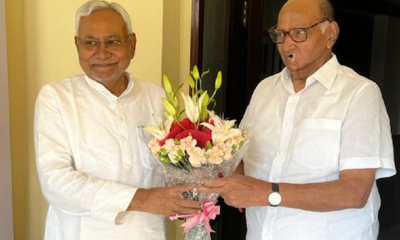National News
Nitish Kumar, socialist leader of Bihar, emerges as challenger to Modi-Shah
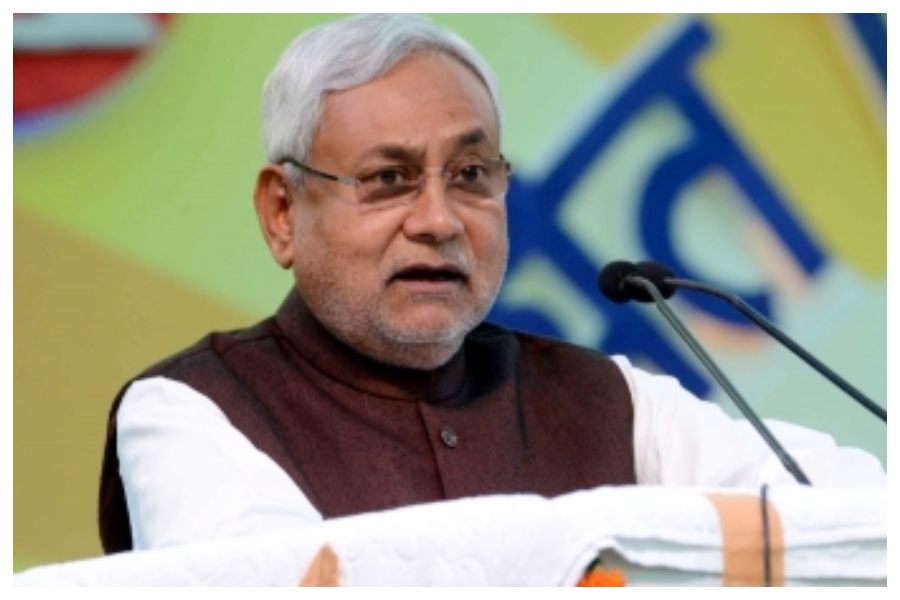
At a time when the duo of Narendra Modi and Amit Shah are dictating terms, Bihar Chief Minister Nitish Kumar not only challenged but also sent a message to the BJP and the RSS about his political daring without caring about the CBI, ED and the Income-Tax department.
Nitish Kumar, a socialist leader of Bihar, was elected as the chief minister for the eighth time.
Kumar, a product of the political school of Karpoori Thakur and Jayaprakash Narayan was influenced by the socialist ideology of these two great leaders of Bihar.
He was influenced by the social justice and making of a Samata Mulak Samaj ideology of Karpoori Thakur and also participated in the Sampoorna Kranti movement in 1977 led by Jayaprakash Narayan.
Nitish Kumar was born in a Kurmi family in Bakhtiyarpur town in Patna district on March 1, 1951. His father was an Ayurvedic doctor, Kaviraj Ram Lakhan Singh and his mother was Parmeshwari Devi.
He obtained a degree in mechanical engineering from the Bihar College of Engineering (now the National Institute of Technology NIT) Patna. During this period, he was influenced by the ideology of two-time former chief minister Karpoori Thakur (the first tenure of Karpoori Thakur was from December 22, 1970 to June 2, 1971 and his second tenure was from June 24, 1977 to April 21, 1979).
Karpoori Thakur headed the Janata Party government having amalgamated with the Bhartiya Jan Sangh which later turned into the Bharatiya Janata Party (BJP).
The Janata Party was influenced by the ideology of Jayaprakash Narayan and Ram Manohar Lohia. They broadly believed in the social philosophies of Mahatma Gandhi and BR Ambedkar.
Karpoori Thakur, during his second tenure, had given 33% reservation to the Backwards in Bihar following the recommendation of the Mungeri Lal Commission. The Bhartiya Jan Sangh which was considered the party of the upper caste people, was not pleased with the decision. Leaders like Kailash Pati Mishra, the then finance minister in the Karpoori Thakur government, revolted against him in April 1979 and he lost his majority in the Bihar assembly.
At that time, Indira Gandhi was undoubtedly the strongest leader in the country. However, the Sampoorna Kranti movement of 1974 put the brakes on her political career.
The Allahabad High Court found Indira Gandhi guilty of rigging the election and imposed a ban for six years on her from contesting elections on June 12, 1975. Indira Gandhi, then imposed an Emergency on the country on June 25, 1975. During the Emergency, leaders like Jayaprakash Narayan, Karpoori Thakur, Ram Manohar Lohia and others were sent to jail. At that time, Lalu Prasad Yadav, Nitish Kumar, Ram Vilas Paswan and others joined the Janata Party and were also jailed.
Nitish Kumar was elected an MLA from Harnaut assembly constituency in Nalanda district in 1985.
In 1989, he contested the Lok Sabha election from Barh constituency in Patna district and won the seat. He was in the VP Singh government and served as union minister of state for agriculture and cooperatives.
VP Singh had implemented the Mandal commission report in the country and the BJP which had 88 MPs had withdrawn its support to Singh. At that time, the Mandal Vs Kamandal politics was going on and BJP leader LK Advani started his Rath Yatra for the demolition of the Babri Masjid.
When the 10th Lok Sabha election was held in 1991, Nitish Kumar was elected again on the ticket of Janata Dal from Barh constituency.
Lalu Prasad Yadav had emerged as the social justice leader of Bihar with his strong vote bank of the Yadav and Muslim communities. He gave strength to the backward, extremely backward, marginalised communities of Bihar and became the strongest leader in Bihar. He became chief minister in 1990 for the first time with the Janata Dal.
Socialist leaders George Fernandes and Nitish Kumar then left the Janata Dal and led the foundation of the Samata Party whose ideology was secularism.
Nitish Kumar was again elected to the Lok Sabha in 1996 with the Samata Party from Barh and George Fernandes won the seat from Nalanda.
He then went with the BJP in the 13-day government of Atal Bihari Vajpayee. When asked why he went with a party whose ideology was just the opposite to his socialist ideology, he told mediapersons that political survival against Lalu Prasad was more important then socialist ideology. This is the survival strength of Nitish Kumar and this is the reason why he became the chief minister of Bihar for the eighth time.
He was again elected in 1998 to the 12th Lok Sabha and served as union minister for railways with the additional charge of the surface transport ministry.
In 1999, he was elected again to the Lok Sabha and became the union minister of railways, surface transport and agriculture in the Atal Bihari Vajpayee government.
He first became the chief minister of Bihar from March 3, 2000 to March 10, 2000.
He contested the Lok Sabha election in 2000 and again served as the union minister of railways and agriculture in the Vajpayee government.
By then, Nitish Kumar had become the tallest leader of the Kurmi-Koiri and other backward class communities. That was the phase when Lalu Prasad was facing charges of fodder scam, and a number of massacres during the first tenure of his wife Rabri Devi’s government from 1996 to 2000.
Nitish Kumar got good support from the backward class apart from his traditional Kurmi-Koiri vote bank. He merged his Samata Party into the Janata Dal-United (JD-U) in 2003. During the 2005 assembly elections, the JD-U managed to win 88 seats and became the single largest party in Bihar. He formed the government in Bihar with the help of the BJP.
Nitish Kumar got the tag of Sushasan Babu of Bihar with a number of welfare schemes like giving reservations to backward classes in government jobs. He gave 50% reservation to women in the electoral process of Panchayati Raj. He worked for social justice in his first term and managed to uproot organised crime like kidnapping for ransom in the state.
He gained the support of the people of Bihar and the JD-U managed to win 118 seats in 2010 assembly election.
As per the statement of senior leader Lalan Singh on Wednesday, Nitish Kumar could have easily formed the government in Bihar but he took the BJP in the government and respected the alliance partner.
In 2013, when the BJP nominated Narendra Modi as the prime ministerial candidate of the NDA, Nitish Kumar objected to it and came out of the NDA.
During the Modi wave in 2014, the JD-U fared badly in the Lok Sabha elections. Nitish Kumar took the responsibility for it and resigned as chief minister. Jitan Ram Manjhi became the CM.
Nitish Kumar took over as chief minister again from Jitan Ram Manjhi in November 2014 and formed an alliance with Lalu Prasad Yadav’s RJD. They made the Mahagathbandhan and also included the Congress party. They won the 2015 assembly election on the formula of 100: 100 seats to the RJD and the JD-U and 43 seats to the Congress.
Lalu Prasad, in 2015 announced that Nitish Kumar will be the chief minister’s face of the Mahagathbandhan. When the election results came in, the RJD won 80 seats, the JD-U 73 and the Congress 29. They managed to stop the BJP at 53 seats in Bihar despite a strong Modi wave.
The RJD, despite having more seats than the JD-U, made Nitish Kumar the chief minister of Bihar.
Apart from Lalu Prasad, the other RJD leaders thought that the chief minister’s post should come to the RJD, and they started targeting Nitish Kumar. A war of words started between the RJD and the JD-U. Nitish Kumar, who has one of the sharpest political brains, started looking for an opportunity and he picked on the corruption charges against Tejashwi Yadav in the IRCTC scam as an ideal excuse for him to come out from the Mahagathbandhan.
Though Lalan Singh, the national president of the JD-U, clarified during a press meet on August 10, 2022 that there were four leaders including Sanjay Jha, Harivansh, RCP Singh and another leader who gave him wrong advice to break the alliance with the RJD and the Congress and join the NDA.
Nitish Kumar joined the NDA in 2017 and formed the government with the help of 53 MLAs of the BJP in Bihar.
In the 2020 assembly election, Nitish Kumar contested under the umbrella of the NDA and became the chief minister of Bihar for the 7th time. After the result of the election, JD-U leaders accused the BJP of back-stabbing their party.
When Nitish Kumar resigned from the post of Chief minister on August 9, he said: “I was not interested in holding the post of chief minister after the 2020 assembly election. They insisted on me. Today’s BJP has a different ideology then the BJP of Atal Ji and Advani Ji.”
“The way BJP was trying to sabotage our party, we have discussed aspects with our MPs, MLAs and MLCs and every one suggested that I come out from the NDA. We have listened to their voices and resigned from the post of chief minister,” Kumar said.
“The National Democratic Alliance (NDA) was formed in 1996 and at that time respected Atal Bihari Vajpayee, LK Advani, Murli Manohar Joshi and George Fernandes were the leaders. The JD-U was associated with the NDA for the next 17 years. The reason was Atal Ji, Advani Ji, MM Joshi Ji, and George Saheb were respecting the coalition partners. Those leaders had principles to respect the coalition partners. And what happened now, BJP is back-stabbing its coalition partners,” Lalan Singh said.
“During the 2019 Lok Sabha election, the BJP wanted to win the polls. Hence, its leaders did not do any mischief. When it came to the 2020 assembly election of Bihar, what they did, BJP leaders back-stabbed us and weakened us,” Lalan Singh said.
Crime
Palghar Crime: Pelhar Police Seize Banned Gutkha Worth ₹6.39 Lakh, Shopkeeper Arrested In Nalasopara
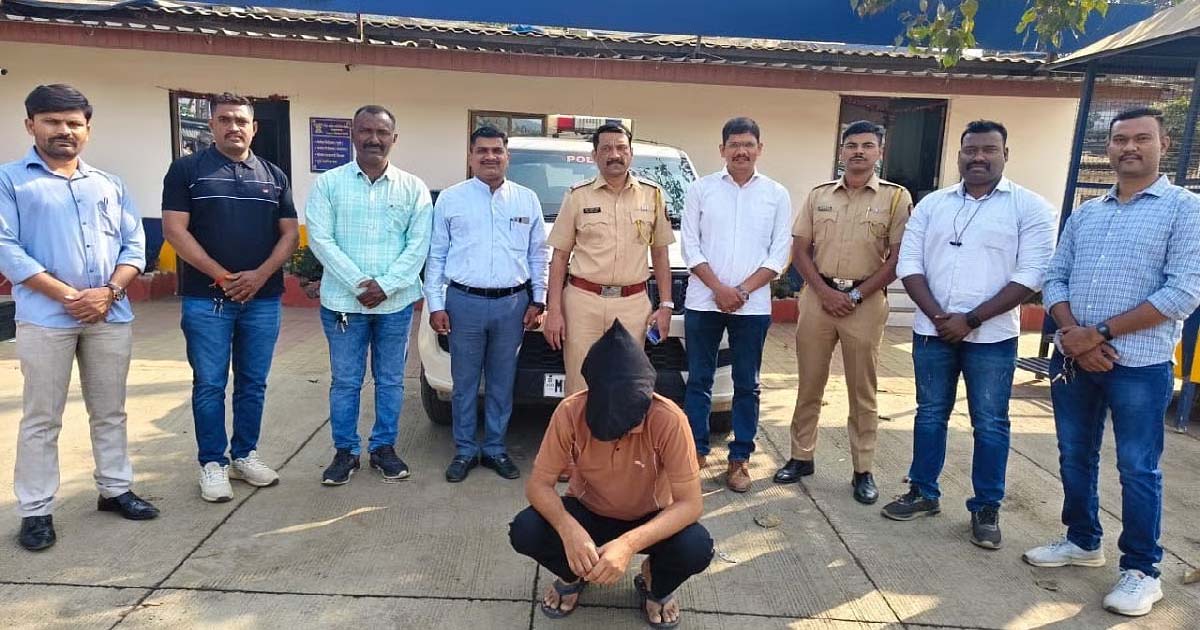
Palghar, Maharashtra, Dec 27: In a significant crackdown on the sale of banned tobacco products, the Pelhar Police arrested a shopkeeper for illegally stocking and selling gutkha, seizing contraband worth ₹6.39 lakh.
According to police, the action was carried out on December 25, 2025, during a routine patrol by Assistant Police Inspector Ramesh Waghchaure along with his team.
Acting on specific and reliable information, the police raided Sana General Stores located at Khan Chowk, Nalasopara Station Road, Nalasopara East, Vasai.
During the raid, the shop owner was found in possession of Maharashtra government-banned tobacco products (gutkha), allegedly kept for sale. The accused has been identified as Javed Ahmed Zaheer Ahmed Ansari (38), a resident of Nalasopara East.
Upon searching the shop premises, police recovered banned gutkha products valued at ₹6,39,493. Following the seizure, Pelhar Police registered a case against the accused, invoking Section 123 of the Bharatiya Nyaya Sanhita along with relevant provisions of the Food Safety and Standards Act, 2006 (Sections 26(2)(i), 26(3), and 26(4)).
Further investigation in the case is being carried out by Waghchaure. Police officials stated that such drives against banned substances will continue to protect public health and ensure strict enforcement of the law.
National News
BMC Elections 2026 | ‘Fight Election, Win Majority’: Sanjay Raut’s Sharp Response To Waris Pathan’s, ‘Why Can’t Khan, Pathan, Shaikh, Qureshi, Syed Become Mumbai Mayor?’ Remark
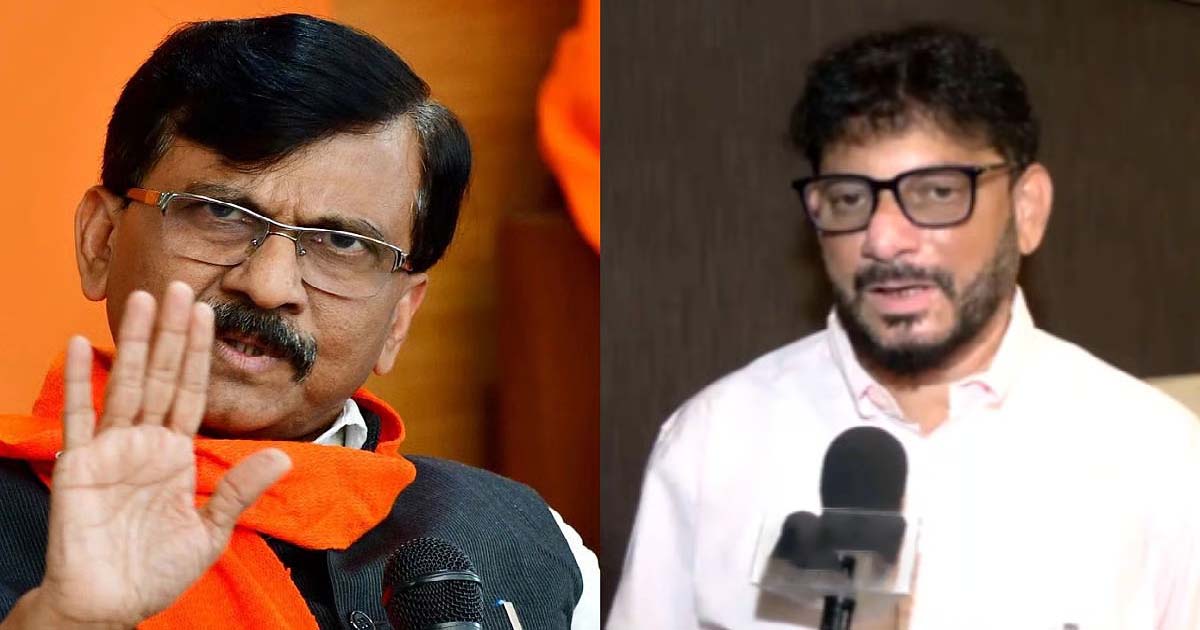
Mumbai: Shiv Sena UBT MP Sanjay Raut on Saturday, December 27, has strongly replied to to remarks made by AIMIM’s national spokesperson Waris Pathan, over who can become the mayor of Mumbai. Pathan had questioned, “Why can’t a Khan, Pathan, Sheikh, Qureshi, Syed become the Mumbai mayor?”
Responding to Pathan’s remarks, Raut said that elections should be fought democratically and decided by numbers. “Fight the election, win a majority and bring in 110 seats,” the Sena UBT MP said. He further added, “We have always maintained that Mumbai’s mayor should be a Marathi-speaking person”, adding that if Waris considers himself a Mumbaikar, he should demonstrate public support through the electoral process.
While speaking to news agency Media, Waris Pathan spoke on the upcoming Municipal Corporation Elections, where he questioned, saying, “Why can’t a Khan, Pathan, Sheikh, Qureshi, Syed become the mayor?”
He claimed that one day a Hijab-wearing woman will also become a mayor. He added, “Muslims have been leaders in the nation already… They (Maharashtra government) have no response to the lack of development and farmers’ suicide… They simply want to spread polarisation…”
NCP leader Zeeshan Siddique said that anyone can be sent to the position of Mayor, while their caste or religion should not matter. He expressed belief that the city needs a person who believes in getting things done.
Further adding, he said, “The mayoral chair should go to someone who has faith in work… If you look around Mumbai, the condition of the city’s roads and infrastructure is poor. Even though BMC receives funds worth thousands of crores, the work does not get done.”
The elections for 227 seats of BMC will be held on January 15, while the counting of votes will be held on January 16. The last polls for the 227 seats were held in February 2017. The BMC elections become crucial as the Mahayuti secured a landslide majority in the 288 municipal councils and nagar panchayats, winning 207 president posts in the local bodies. The Opposition Maha Vikas Aghadi could come up with a collective tally of 44.
In the BMC polls, the total number of registered voters stands at 1,03,44,315 across all wards, of which 55,16,707 are male voters, 48,26,509 are female voters, while 1,077 voters are listed under the ‘other’ category.
Crime
Mother strangles 6-year-old to death in Navi Mumbai for not speaking Marathi
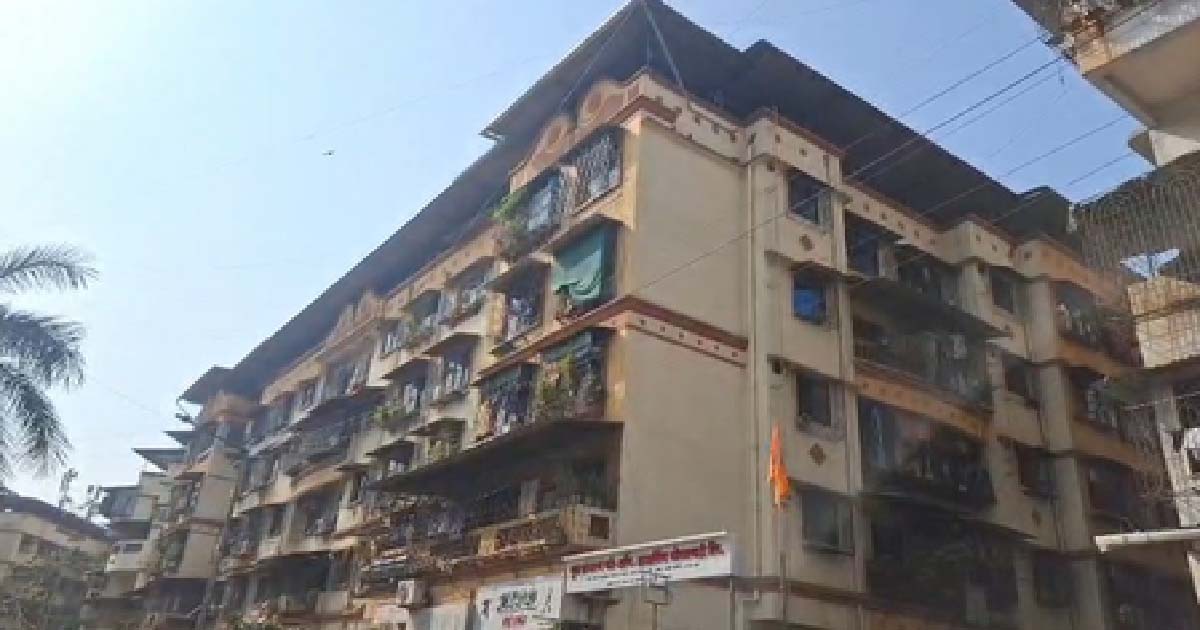
Navi Mumbai, Dec 27: In a shocking and disturbing incident from Navi Mumbai, a woman allegedly murdered her six-year-old daughter because the child could not speak Marathi, sending shockwaves across the city.
The police have arrested the mother in connection with the case after attempts were made to pass off the child’s death as a heart attack.
The incident came to light after the police grew suspicious of the circumstances surrounding the child’s death and ordered a post-mortem examination, which revealed that the girl had died due to asphyxiation.
Following intensive questioning, the truth behind the incident was uncovered.
The heart-wrenching crime was reported from the Kalamboli suburb of Navi Mumbai. In Gurusankalp Housing Society in Sector-1, Kalamboli, the 30-year-old woman allegedly strangled her own six-year-old daughter to death.
The Kalamboli police have arrested the woman and initiated further investigation into the matter.
According to information provided by the police, the family consisted of an IT engineer husband and his wife, who holds a B.Sc. degree. The couple got married in 2017 and welcomed their daughter in 2019.
However, from a very young age, the child reportedly had difficulty speaking and mostly communicated in Hindi instead of Marathi.
This reportedly became a recurring source of anger for the mother. During the investigation, it emerged that she often expressed resentment about the child’s speech, repeatedly telling her husband, “I don’t want such a child; she doesn’t speak properly.”
The husband, police said, had tried to reason with her on several occasions.
On the night of December 23, the woman allegedly decided to kill the child. Coincidentally, the grandmother had visited the house that day, but could not meet the girl.
Later, when the husband returned home and found the child unresponsive, the family rushed her to the hospital.
At the hospital, an initial claim was made that the child had suffered a heart attack. However, Senior Police Inspector Rajendra Kote of Kalamboli Police Station found the circumstances surrounding the death suspicious and ordered a post-mortem examination.
The preliminary medical report indicated obstruction of the airway, pointing towards asphyxiation.
Following this revelation, the police subjected the parents to sustained questioning. After nearly six hours of interrogation, the mother allegedly confessed to strangling her daughter.
She has since been arrested in connection with the crime.
It has also come to light during the investigation that the woman was undergoing treatment with a psychiatrist.
The police are continuing their probe to ascertain all aspects related to the case and the mental condition of the accused.
-

 Crime3 years ago
Crime3 years agoClass 10 student jumps to death in Jaipur
-

 Maharashtra1 year ago
Maharashtra1 year agoMumbai Local Train Update: Central Railway’s New Timetable Comes Into Effect; Check Full List Of Revised Timings & Stations
-

 Maharashtra1 year ago
Maharashtra1 year agoMumbai To Go Toll-Free Tonight! Maharashtra Govt Announces Complete Toll Waiver For Light Motor Vehicles At All 5 Entry Points Of City
-

 Maharashtra1 year ago
Maharashtra1 year agoFalse photo of Imtiaz Jaleel’s rally, exposing the fooling conspiracy
-

 National News1 year ago
National News1 year agoMinistry of Railways rolls out Special Drive 4.0 with focus on digitisation, cleanliness, inclusiveness and grievance redressal
-

 Maharashtra1 year ago
Maharashtra1 year agoMaharashtra Elections 2024: Mumbai Metro & BEST Services Extended Till Midnight On Voting Day
-

 National News1 year ago
National News1 year agoJ&K: 4 Jawans Killed, 28 Injured After Bus Carrying BSF Personnel For Poll Duty Falls Into Gorge In Budgam; Terrifying Visuals Surface
-

 Crime1 year ago
Crime1 year agoBaba Siddique Murder: Mumbai Police Unable To Get Lawrence Bishnoi Custody Due To Home Ministry Order, Says Report



